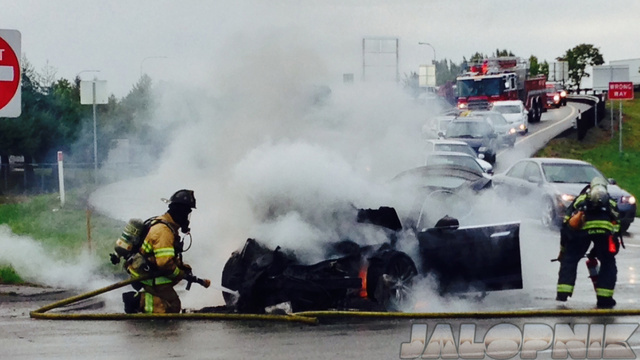Tesla CEO Elon Musk has taken to the company blog today to talk about a Tesla Model S fire that caught the attention of the news media this week. Musk says that the fire was caused by a piece of a tractor-trailer that punctured the battery compartment of the car with a “peak force on the order of 25 tons.”
The owner of the car, says Musk, was able to pull off of the road safely and exit the car. The fire began in the front module and was “contained to the front section of the car,” Musk writes, and never entered the passenger compartment.
“Earlier this week, a Model S travelling [sic] at highway speed struck a large metal object, causing significant damage to the vehicle,” Musk said. “The geometry of the object caused a powerful lever action as it went under the car, punching upward and impaling the Model S with a peak force on the order of 25 tons. Only a force of this magnitude would be strong enough to punch a 3 inch diameter hole through the quarter inch armor plate protecting the base of the vehicle.”
Musk was also careful to point out statistics that show that gas vehicles are just as susceptible, if not more so, to a similar kind of impact. “Had a conventional gasoline car encountered the same object on the highway, the result could have been far worse,” the Musk letter says. “A typical gasoline car only has a thin metal sheet protecting the underbody, leaving it vulnerable to destruction of the fuel supply lines or fuel tank, which causes a pool of gasoline to form and often burn the entire car to the ground.”
Musk quotes statistics that he says point to the fact that you are 5 times more likely to experience a fire in a gas-powered car than a Tesla. Musk notes that a gas tank is typically only protected by a thin sheet of metal, not the quarter-inch “armor plate” that’s featured in Teslas. Musk also trots out numbers — a move reminiscent of his mostly successful campaign against a negative NY Times review — related to car fire safety. Over 150,000 car fires per year, one vehicle for every 20 million miles and one fire in over 100 million miles driven for Teslas equate to the “5x” figure that Musk notes.
At this point it’s probably important to note that Tesla has only been around for a few years, while conventional gas vehicles have had a lot more ‘miles driven’ to have an opportunity to catch on fire. Still, the track record of the company with regards to road safety and fires does pull a stark contrast.
This is in obvious response to the media attention the fire got, and the fact that some of the stock pullback that Tesla has experienced in the last few days was attributed to a viral video shot of the fire on a Washington highway. That pullback was likely more about convertible notes and a downgrade by Baird, but the timing of the fire has to be seen as brutal by Tesla PR and company watchers.
Musk also published correspondence between the company and the owner of the car, Robert Carlson. In the correspondence, Carlson seems satisfied with the explanation of the fire.
“I guess you can test for everything, but some other celestial bullet comes along and challenges your design,” Carlson’s letter says. “I agree that the car performed very well under such an extreme test. The batteries went through a controlled burn which the internet images really exaggerates. Anyway, I am still a big fan of your car and look forward to getting back into one. Justin offered a white loaner–thanks.”
Carlson goes on to note that he is an investor, and says he expected something like this to happen to Tesla at some point, perhaps just not to him. “But now it is out there and probably gets a sigh of relief as a test and risk issue-this “doomsday” event has now been tested,” Carlson concludes, “and the design and engineering works.”
Image via Jalopnik
